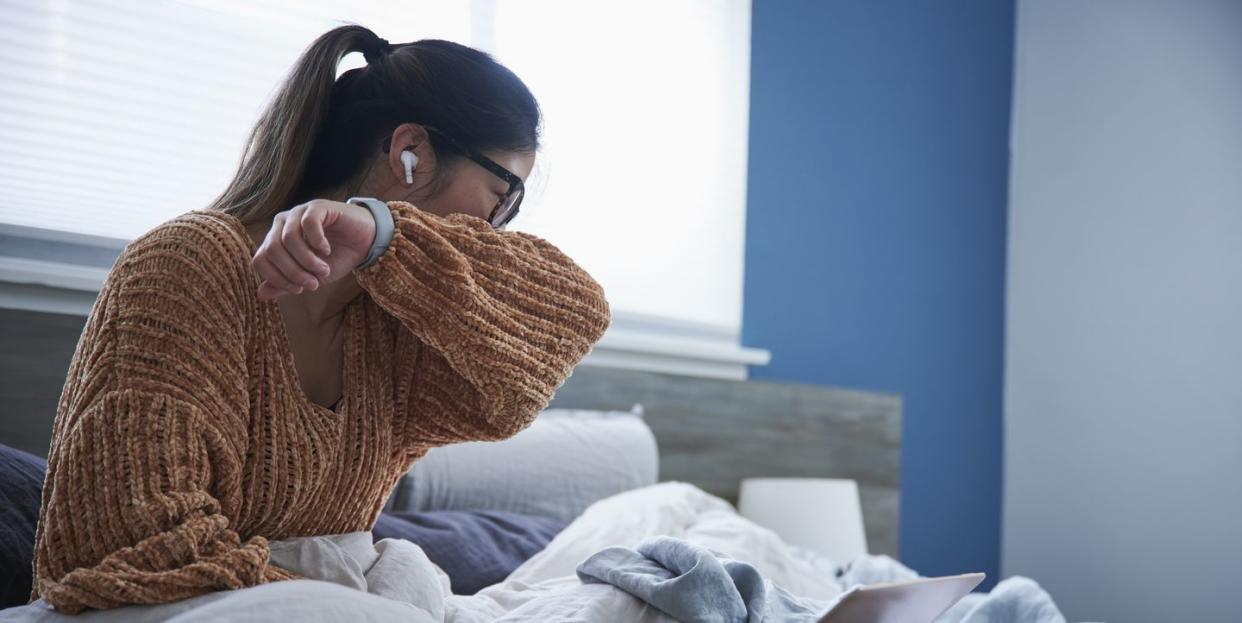How to Treat and Recover From COVID-19 at Home

- Oops!Something went wrong.Please try again later.
"Hearst Magazines and Yahoo may earn commission or revenue on some items through the links below."
With the massive wave of COVID-19 infections that have happened lately, more Americans are getting sick with the virus. And, given that the Omicron variant tends to cause a more mild form of illness—particularly in people who are fully vaccinated—most people are treating their symptoms at home. Of course, that raises the very important question of how to treat COVID at home.
Recommendations on how to manage the virus have changed slightly since the pandemic began. Now, doctors have a pretty good idea of what works and what doesn’t when it comes to at-home COVID-19 treatments. So, what can you do to treat COVID at home? Doctors say it’s largely focused on addressing your symptoms. Here’s everything to keep in mind.
What are the symptoms of COVID-19 again?
The Centers for Disease Control and Prevention (CDC) hasn’t updated its list of COVID-19 symptoms since February 2021, when the Delta variant was the predominant strain of COVID-19 circulating in the U.S. According to that list, the main symptoms of COVID-19 include:
Fever or chills
Cough
Shortness of breath or difficulty breathing
Fatigue
Muscle or body aches
Headache
New loss of taste or smell
Sore throat
Congestion or runny nose
Nausea or vomiting
Diarrhea
However, Omicron is now responsible for 99.5% of all COVID-19 infections the country. A mid-December report shows this variant causes slightly different symptoms, which most commonly include:
Cough
Fatigue
Congestion
Runny nose
Still, it’s entirely possible to have a fever, headache, muscle and body aches, and all of the other symptoms that were associated with previous strains of COVID-19, says Thomas Russo, M.D., professor and chief of infectious disease at the University at Buffalo in New York.
How to treat COVID-19 at home
Doctors say there are a few things you can do to make yourself comfortable at home when you have COVID-19.
Take OTC pain and fever-reducing medications
If you’re struggling with a headache, fever, and body aches, OTC pain medication should help, Dr. Russo says. He suggests starting with acetaminophen (Tylenol) and seeing how you feel. “If that’s not enough, NSAIDs like ibuprofen or naproxen are the next step,” he says.
Use cough medicine and decongestants, if needed
Not everyone with COVID-19 develops a cough and runny nose, but many people do. That’s why it’s a good idea to consider over-the-counter cough syrup and decongestants if you’re uncomfortable, says Richard Watkins, M.D., an infectious disease physician and professor of internal medicine at the Northeast Ohio Medical University.
Medicine like dextromethorphan-guaifenesin (Robitussin DM) can help with a cough, while pseudoephedrine (Sudafed) can ease sinus discomfort, Dr. Russo says. “A lot of the same remedies you would use for a cold can be helpful,” he adds.
Drink plenty of water
Staying well hydrated is important under normal circumstances, but particularly when you’re sick. “Preventing dehydration is important” when you have COVID-19, especially if you have a fever because you tend to sweat a lot, says Amesh A. Adalja, M.D., a senior scholar at the Johns Hopkins Center for Health Security.
The U.S. National Academies of Sciences, Engineering, and Medicine says that men should strive to have at least 15.5 cups of fluids a day, and women should aim for 11.5 cups of fluids daily—from food and drink. You can also monitor the color of your urine to see if you’re well hydrated (it should be a pale yellow color).
Get rest
The reason for this is simple, per Dr. Watkins: “So your immune system has energy to fight the infection.” You also may be feeling tired from the virus itself, and making sure to rest will up help. “Sleep can help diminish the fatigue and severity of some of the symptoms,” Dr. Adalja says.
Keep tabs on your blood oxygen levels
Having a pulse oximeter, which measures the saturation of oxygen in your red blood cells, at home—and actually using it—can be helpful, Dr. Russo says. It’s a good idea to consult your doctor when your reading drops below 95%, he says, particularly if it’s been higher than that in the past.
When to call your doctor
If you have an underlying health condition that qualifies you for treatment with monoclonal antibodies or the antivirals Paxlovid or molnupiravir, it’s important to call your doctor after you test positive for COVID-19 to help you get treatment, Dr. Russo says. (The National Institutes of Health breaks down qualifying conditions online.)
But, if you don’t have any underlying health conditions that put you at high risk of COVID-19 complications, Dr. Adalja recommends monitoring your symptoms and calling your doctor if you get worse. That includes experiencing things like being short of breath, having a fever that won’t break, and being “so extremely fatigued that you cannot perform your activities of daily living,” he says.
Experiencing chest palpitations, confusion, and developing blue lips and nails should also prompt a call to your doctor, Dr. Russo says.
But, in general, most people are OK to ride out the illness at home, Dr. Russo says.
This article is accurate as of press time. However, as the COVID-19 pandemic rapidly evolves and the scientific community’s understanding of the novel coronavirus develops, some of the information may have changed since it was last updated. While we aim to keep all of our stories up to date, please visit online resources provided by theCDC, WHO, and your local public health department to stay informed on the latest news. Always talk to your doctor for professional medical advice.
You Might Also Like

